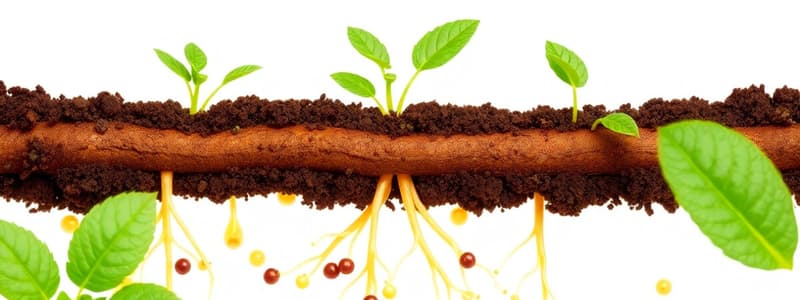Podcast
Questions and Answers
What is the primary process involved in the movement of sap from source to sink in plants?
What is the primary process involved in the movement of sap from source to sink in plants?
- Gravity-driven flow
- Diffusion
- Pressure-flow hypothesis (correct)
- Evaporation
Which of the following is NOT a passive absorption mechanism in plants?
Which of the following is NOT a passive absorption mechanism in plants?
- Ion exchange
- Carrier concept (correct)
- Mass flow
- Donnan equilibrium
What role do plasmodesmata play in the translocation of food in plants?
What role do plasmodesmata play in the translocation of food in plants?
- They store excess organic substances.
- They transport the sap directly to the roots.
- They facilitate the entry of molecules into sieve tubes. (correct)
- They block food from entering the sieve tubes.
How is sucrose loaded into phloem tubes?
How is sucrose loaded into phloem tubes?
What typically defines the direction of phloem transport in plants?
What typically defines the direction of phloem transport in plants?
What is the main significance of sugars being converted from glucose and fructose in plants?
What is the main significance of sugars being converted from glucose and fructose in plants?
Which theory explains the mechanisms of ion absorption in plants?
Which theory explains the mechanisms of ion absorption in plants?
Which substance is NOT mentioned as being translocated in the phloem?
Which substance is NOT mentioned as being translocated in the phloem?
Flashcards are hidden until you start studying
Study Notes
Absorption of Solutes
- Plants absorb nutrients from the soil via passive and active absorption methods.
- Passive Absorption utilizes mechanisms like mass flow, ion exchange, and Donnan equilibrium.
- Mass Flow: Movement of solutes along with water flow from high to low concentration areas.
- Ion Exchange: The process where cations in the soil solution are exchanged for cations held by the soil particles.
- Donnan Equilibrium: Movement of ions across a semipermeable membrane driven by concentration gradients.
- Active Absorption: Requires metabolic energy to move solutes against their concentration gradient.
- Carrier Concept: Proteins or other molecules bind to specific solutes and facilitate transport.
- Protein-Lecithin Carrier: This theory suggests that proteins and phospholipids act as carriers for solutes.
- Goldacre's Theory: Involves the movement of ions across a membrane using a potential difference.
- Cytochrome Pump Theory: Electrons released from oxidation reactions drive the movement of ions across the membrane.
Translocation of Food
- Direction of Phloem Transport: Primarily from the leaf (source) to the root (sink), but can also occur upwards towards the shoot meristem.
- Components Transported: Primarily sugars (mainly sucrose), amino acids, and other organic molecules.
- Phloem Loading: Sugars are actively transported from mesophyll cells into sieve tubes of the phloem.
- Pressure Flow Hypothesis: The widely accepted theory explaining the movement of sap within the phloem.
- Mechanism: Sugars are loaded into sieve tubes using active transport, which increases the solute concentration and draws water in via osmosis, creating a pressure gradient responsible for the movement of sap.
- Source-Sink Dynamics: The leaf is the source of sugar due to photosynthesis, while the root is a major sink, but sinks can also include growing stems, fruits, and flowers.
Studying That Suits You
Use AI to generate personalized quizzes and flashcards to suit your learning preferences.




